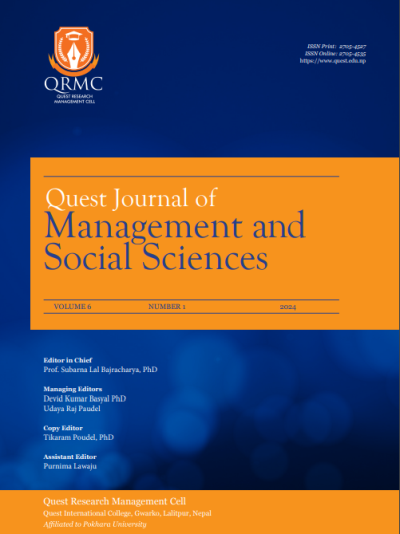Analysing Customers’ Perception on QR Payment in Kathmandu Valley: An Empirical Study using UTAUT and PLS-SEM
DOI:
https://doi.org/10.3126/qjmss.v6i1.67216Keywords:
QR Payment, Performance expectations, Social influence, Effort expectancy, Facilitating conditionsAbstract
Background: The growing use of the Fintech industry significantly impacts the popularity of QR payment. The easy and convenient use of digital payment systems has increased the adoption of QR payments. The study analyses customers' perceptions of QR payment in the Kathmandu Valley.
Methods: The study uses explanatory research design to analyse the connections and causal effects between the determinants that affect the customer perceptions of using the QR payment system in the Kathmandu Valley. Non-probability sampling with convenient sampling is used for the study. Data is collected from 280 customers who have used QR payment services using the Structural Questionnaire through the Kobo Toolbox. Similarly, the Structural Equation Modeling (SEM) using the Partial Least Square (PLS) version 4.0 is adopted for analysis.
Results: The study highlights a growing trend among respondents, with an increasing number habitually using QR payments for 1-3 years. E-sewa, Fone pay, and Connect IPS are popular choices for activities like fund transfers and bill payments. Despite facing challenges such as technical glitches and debited funds from failed transactions, respondents view QR payments as a convenient method. However, these challenges can be addressed through regular maintenance, enhanced internet infrastructure, transaction flexibility, stable connectivity, and improved system performance.
Conclusions: The result shows a significant relationship between the independent variables, such as performance expectation and facilitating conditions and the dependent variable, i.e., customer perception. It indicates that when users perceive higher performance benefits from QR payment, their overall perception improves. Similarly, when users perceive a favourable environment for QR payment adoption, their perception is positively influenced, enforcing the increasing use of QR payment.
Paper Type: Research Type
Downloads
Downloads
Published
How to Cite
Issue
Section
License
Copyright (c) 2024 Quest Journal of Management and Social Sciences

This work is licensed under a Creative Commons Attribution-NonCommercial-NoDerivatives 4.0 International License.
This license enables reusers to copy and distribute the material in any medium or format in unadapted form only, for noncommercial purposes only, and only so long as attribution is given to the creator.




